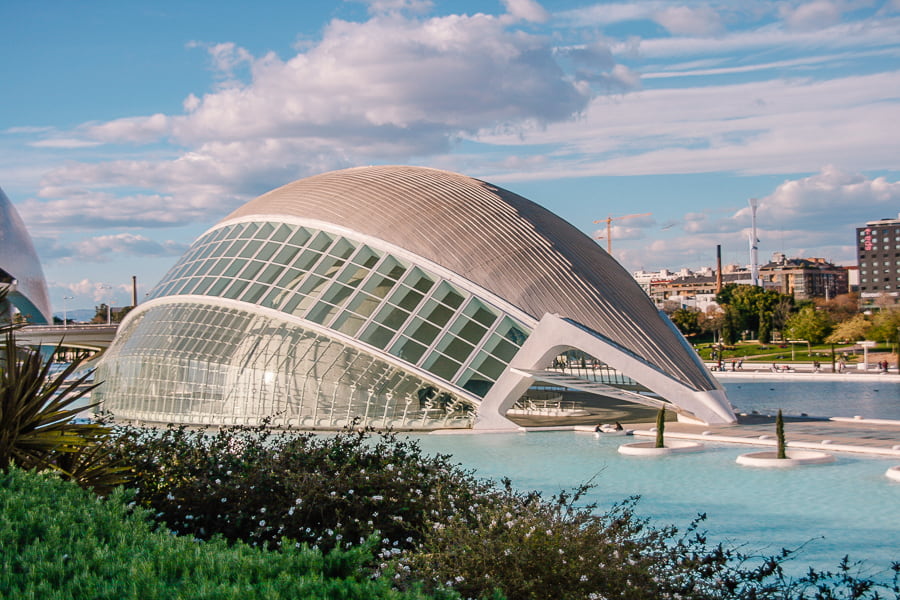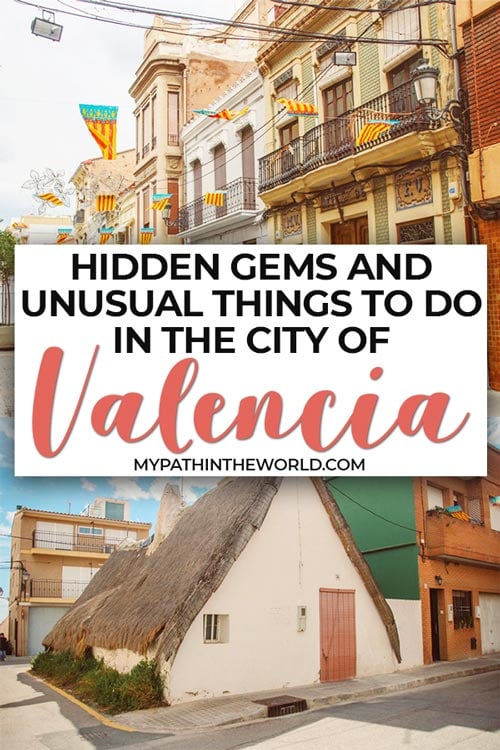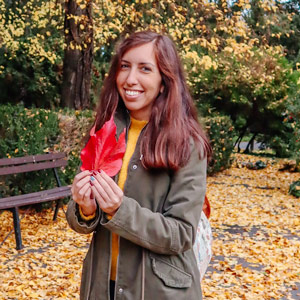Unlike Madrid and Barcelona, Valencia is still quite an underrated and undiscovered city in Spain, but of course, it has its must-sees and typical attractions.
So if you’ve already marked places like the Central Market, the Cathedral, and the Turia Gardens, here are some remarkable hidden gems in Valencia (and alternative experiences).
*This post may contain affiliate links from which I earn a commission (for more info, read my disclosure). As an Amazon Associate, I earn from qualifying purchases. This post may show pop-ups.
*I try to keep the information on this blog as updated as possible, but I still recommend consulting the latest prices, opening hours, and other details on the official website of each site, hotel, and tour, as well as checking the updated public transport routes and timetables.
Quick Suggestions for Your Trip
Highly-rated alternative experiences in Valencia:
1. Free mysteries and legends night tour
2. Hidden gems of the Old Town + a meal in an 11th-century monument
Book one of these highly-rated day tours:
1. Thermal springs and waterfalls day trip
2. Morella & Peñíscola, two historic towns with medieval castles
3. Utiel-Requena wine region (with tastings)
4. Altea, Villajoyosa, and Benidorm, three charming towns
5. St Joseph’s Caves with a boat ride on the longest underground river in Europe
Highly-rated accommodations in Valencia’s city center:
1. L’Esplai Valencia (mid-range)
2. Hotel Helen Berger (boutique)

Alternative Things to Do and Hidden Gems in Valencia
Take a Few Unique Tours (Some Are Free!)
No matter what city you’re traveling to, I always recommend taking a themed tour that will show you another side of it.
Apart from a classic free tour of Valencia’s old town, check out these highly-rated alternative tours:
2. Free mysteries and legends night tour: To uncover Valencia’s dark side.
3. Hidden gems of the Old Town + a meal in an 11th-century monument: Explore Valencia’s old town and get exclusive access to an 11th-century landmark, where you’ll have a 10-course meal with wines.
Stroll Through a Few Lesser-Known Gardens
Parks and gardens are always fun places to add to your city break itinerary, and if you did some research on Valencia, you probably read about the Turia Gardens, Jardins del Real, and maybe even the botanical garden.
But since you’re eager to explore Valencia off the beaten path, you might want to check out gorgeous (and free) yet lesser-known spots like Jardines de Monforte, Jardí d’Aiora & its palace, and Jardín de Las Hespérides (which is inspired by Greek mythology).
See Europe’s Narrowest Building: La Estrecha
Only 107 cm (about 42 inches) wide, La Estrecha is the narrowest building in Europe and the second narrowest in the world.
While some argue that Europe’s narrowest building is actually in Amsterdam, I prefer not to be too pedantic and just enjoy this surprisingly cool spot.
Location: In the middle of Valencia’s city center, at Plaza Lope de Vega.

Grab a Bite at the Mossen Sorell Market
Situated in the old town neighborhood of El Carmen, this small yet delightful indoor boutique-style market is a wonderful place to explore.
Whether you’re looking to buy some fresh produce or just grab a bite and enjoy a glass of wine, it is a great little addition to include in your itinerary.
Location: Avenida de Burjassot 54.
Spend Some Time at Mercado de Tapineria
Mercado de Tapineria is not your usual market. It is a creative area home to a market that changes every week, two gastronomic spaces, and two small public squares.
The market also hosts live music performances, exhibitions, and workshops (see the latest events here).
Besides the cute little antique market that was open during my visit, I loved the overall concept of one intimate and minimalist place where you can spend your time eating, drinking, shopping, and just relaxing.
Location: 15-17 Tapineria Street.

Witness a Thousand-Year-Old Tradition
Have you ever heard of the Tribunal de Las Aguas (The Water Court)?
Well, it is actually the oldest law institution in Europe that still exists. Its job is to settle issues regarding one of the biggest irrigation systems in the region.
If you visit Valencia’s Cathedral on a Thursday at noon, you’ll find the court, which consists of eight farmers, meeting right outside the main entrance (The Door of the Apostles).
Note that it is not a show. It is a real functioning court, so please be respectful.
Take a Picture Next to La Casa de Los Gatos (The Cats’ House)
La Casa de los Gatos is a miniature house in the neighborhood of El Carmen that serves as a shelter for the neighborhood’s cats. It is a quirky spot, but interestingly enough, it is a homage to a legend called ‘The Four Cats.’
According to the legend, during El Cid’s rule in Valencia, he ordered to make all the city’s cats disappear because the Catholics believed that they were diabolical and brought bad luck. Allegedly, after that incident, only four cats remained in the city.
Location: 9 Museo Street.

Look for Cross-Stitched Street Art
One of the most unique things to do in Valencia is to explore its street art scene, which blew my mind.
But here’s something a bit unusual – on different streets of Valencia, you can come across a large-scale floral embroidery of the artist Raquel Rodrigo. She decorates houses and stores, leaving little drops of joyful art for you to enjoy.
Location: Unfortunately, some are currently damaged, but here are a few locations where you can find Raquel’s art.
Walk Along Puente de Las Flores (The Flowers Bridge)
Not that Valencia lacks color, but Puente de las Flores is a pop of color you cannot miss.
The bridge, which crosses the famous Turia Gardens, is gracefully adorned with a vivid carpet of flowers that changes a few times a year according to seasons and festivities.
The bridge is sometimes neglected due to the high costs of its maintenance, so I can only hope you will enjoy the same vibrant layout as I have seen during my visit to the city.

Visit the Silk Museum
The Silk Exchange (La Lonja de la Seda) is a UNESCO World Heritage Site and one of the top landmarks in Valencia (as the city was a major silk trade hub back in the 15th-18th centuries).
But did you know you could also visit a museum dedicated to silk?
Housed in the former College of High Silk Art, it will take you through the history of silk in Valencia, including the production process, its use in traditional Valencian clothes, and more.
Location: Carrer de l’Hospital 7.
Go Inside the Estacio Del Nord Railway Station
Estacio del Nord is Valencia’s central railway station and probably one of the most overlooked places in the city.
Besides appreciating its impressive detailed facade, you should enter the building and admire its interior.
Take some time to wander around and explore the astounding decorations of colorful mosaics, tiles, and stained glass windows.

Visit a Quirky Miniature Museum
Valencia is home to many museums, but Museo de Soldaditos de Plomo L’iber is pretty unusual, being the world’s biggest museum of historical miniatures!
With a collection of more than 1,000,000 pieces (though only 95,000 are on display), it has several exhibition rooms. Some tell the history of Valencia and Spain, and others are dedicated to eras like prehistory and ancient history.
Location: Carrer dels Cavallers, 20 – 22.
Spend a Couple of Hours in Port Saplaya
Located less than 8 km (5 miles) from Valencia’s city center and reachable by bus, Port Saplaya is a cute little port town known as the Valencian Venice.
While you won’t find “real attractions” in Port Saplaya like historical landmarks or museums, this adorable beach town is a great place to enjoy a few laid-back hours.
You can soak up the sun on the beach, grab a bite at one of the many restaurants along the promenade, and take photos of the charming, colorful, Venice-style port.
Visit the Rice Museum
It’s not every day that you come across a museum dedicated to rice, but since Valencia is the region where paella was born, it shouldn’t come as a surprise.
While the museum is not very big, it’s still pretty cool to see all the machinery involved in the process of producing rice and learn a bit more about its journey from when it arrives from the field until it is placed in bags.
Location: Carrer del Rosari 3.
Try Unique Ice Cream Flavors
I admit this one is still on my bucket list, but since we are talking about unusual things to do in Valencia, it has to be on the list.
If you’re feeling brave enough to face super unconventional ice cream flavors, head over to one of the branches of Heladeria Llinares.
They’re not always available, but when they are, you can find flavors like cucumber, gazpacho, smoked salmon, tomato, and tortilla de patatas (a Spanish potato omelet).
I have yet to try it, but their ice cream is a gastronomic experience I am not going to miss on my next trip to Valencia.
Take a Stroll in the Streets of El Cabanyal
Valencia’s different neighborhoods are one of the reasons I fell in love with this city.
Getting lost in the old town district’s neighborhoods like El Carmen and La Seu was a real adventure. However, exploring the streets of their underrated friend, El Cabanyal, was by far one of my favorite alternative things to do in Valencia.
El Cabanyal is Valencia’s old fisherman’s quarter, located right next to La Malvarrosa beach. At first sight, it might not seem beautiful because many of its buildings are neglected, but give it a moment.
The traditional Spanish tiles decorating the houses; the mix of architectural styles; the colorful facades; combine all of these with the vibe of an old village and you have got yourself something I like to call magic.

Go Fan Shopping
Usually, I do not mind buying a few magnets and other cheesy souvenirs (secretly I really love them). However, for me, finding an authentic one is like finding a little treasure. And what’s more authentic than buying an artisanal Spanish fan?
The Carbonell family has been making handcrafted fans since 1860. At their shop, Abanicos Carbonell, you can find all sorts of fans – from different materials to various styles, they are masters in producing elegant fans.
Since we are talking about high-quality handmade fans, some of their products are very pricey, especially antique ones.
However, they also sell more affordable fans which are beautiful as well. In any case, I recommend visiting the shop to take a look at some masterpiece artisanal fans, even if you’re not buying anything.
Location: 21 Castellon Street.
DISCOVER THE INCREDIBLE ARCHITECTURE OF CASA JUDIA (‘JEWISH HOUSE’)
If you’re looking for secret places in Valencia, Casa Judia is a gem I was thrilled to discover.
Alongside ordinary-looking apartment buildings, stands this mesmerizing art deco house. It was built in 1930 for a Spanish Jewish man, which is how it got its name and why a Star of David is outlined on the building’s lintel.
This fact alone made Casa Judia worth my while, as I am a total sucker for anything related to my Jewish heritage.
Besides the little Jewish homage, Casa Judia’s architecture is completely captivating. With so many unique architectural elements and colors harmoniously combined, it is impossible to stay indifferent to such a work of art.
Location: 20 Castellon Street.

Visit the Bomba Gens Art Center
Valencia is home to quite a few art museums, but in the guidebooks, you’ll read about the Museum of Fine Arts or the Valencian Institute of Modern Art before you find any info on Bomba Gens.
This center is housed in an old factory and hosts changing exhibitions by both local and international artists.
See what’s on the agenda as some exhibitions require making a reservation in advance.
Location: Avenida de Burjassot 54.
Visit the Centre Del Carme Cultural Space
If you are looking for an interesting way to spend a couple of hours in the afternoon, this is the place for you. Centre del Carme is a 13th-century monastery converted into a cultural center in the El Carmen neighborhood.
What I like about this place is that you get to enjoy both the different exhibitions in the center and the beauty of the old monastery.
Plus, the center is open to the public for free, so it is also a great option for seeing Valencia on a budget.
Location: 2 Museo Street.
Take a Half-Day Trip to the Paella’s Birthplace
The region of Valencian is famous for being the origin of the delicious paella, but its specific birthplace is the area of the Albufera Natural Park.
The park is home to the largest lake in Spain, and it is an ecologically important place with rich and diverse flora and fauna.

To enjoy the park, go to El Palmar, a small village sitting on the lake. In El Palmar, you can take a boat ride and learn from a local guide about the lake and the park.
You can also see the rice fields and try some delicious paella in one of the village’s many paella restaurants (I recommend Restaurante Mateu).
Another cool thing to see in El Palmar and during the boat ride is the barracas. A barraca is a traditional house in which farmers of the area used to live. Most of the barracas sit on the lake, but there are also a few standing in the village itself.

Getting from Valencia to El Palmar: Take bus number 24. The village is only 10 km away from Valencia.
Looking for more adventures outside the city? Take a day trip to Valencia’s hot springs, waterfalls, and mountains!

Visit Casa Museo Benlliure (Benlliure House-Museum)
Spain is home to many enchanting house museums that belonged to famous painters, writers, and other cultural figures.
In Valencia, you’ll find the house museum of the painter José Benlliure Gil, where you can get a glimpse into his life.
Adorning the different rooms and the adorable garden, you’ll see his own paintings, as well as works by other artists, 19th-century furniture, and colorful tiles.
You won’t find this museum in the top 10 or even 20 attractions in the city, so it’s definitely a non touristy place in Valencia.
Location: Carrer de la Blanqueria 23.
Attend an Incredible Festival
There’s no way like attending a festival to get to know and experience the local culture.
Las Fallas is one of the most famous festivals in Valencia and what makes the city such a fantastic early spring destination in Europe.
The festival that takes place in March is a celebration of the beginning of spring along with Saint Joseph’s Day.
It includes parades, firework shows, illuminated streets, and most importantly – gorgeous displays of colorful sculptures that look like they belong in a child’s imagination. According to the tradition, most of them get burned on the final night of the festival.
Strolling the city during this time, I felt like a kid in a candy store. Read my full guide to the Fallas festival and see why you have to attend it at least once in your life (two times were not enough for me).

Visit the Museo Del Gremio de Artistas Falleros
Apart from attending the Fallas festival, you can also visit two museums dedicated to it.
The more familiar one is the Museo Fallero, which houses the sculpted figures (called ninots) that have been chosen to survive the fire.
The second one, which often gets overlooked (maybe because it’s a bit far from the center), is the Museo del Gremio de Artistas Falleros.
In this lovely museum, you can see the figures that the artists guild has chosen to rescue from the flames, as well as original sketches, the evolution of the ninots, and more.
Location: Avinguda Sant Josep Artesà 17.
Visit the Prehistory Museum of Valencia
Another museum you probably didn’t think you could find in Valencia is the Prehistory Museum.
Boasting a collection of archeological artifacts from the Paleolithic, Neolithic, Iberian, Greek, Roman, and Visigoth periods, there’s no better place to immerse yourself in the thousands of years of the city’s history.
Location: Centro Cultural La Beneficència, Carrer de la Corona 36.
Other Spain Travel Guides
Read more about Spain:
- Valencia travel tips
- Hidden gems in Spain
- Landmarks in Spain
- Spain travel quotes
- Best road trips in Spain
- Novels about Spain
- Spain themed gifts
- Spain travel tips
- Long weekend breaks in Spain
Related posts:
- Hidden gems in northern Italy
- Hidden gems in southern Italy
- Hidden gems in Puglia
- Hidden gems in Turin
- Hidden gems in Milan
- Hidden gems in Madrid
- Hidden gems in Barcelona
- Hidden gems in Mallorca
- Hidden gems in Portugal
- Hidden gems in Budapest
- Hidden gems in Krakow
- Hidden gems in Kefalonia
Pin for later!




Loved this article. I’m leaving for Valencia in a few weeks and can’t wait to see al these cool things. Thanks!
Thank you so much and have a great time in Valencia, Jasmijn 🙂
Hey Or, thanks for this an all your other Valencia tips, which we benefited from during the time we lived there. I added Heladeria Linares to my must-eat list then… like you didn’t get around to it, haha. Dang it. Oh well. Had a great time in Valencia nonetheless. Thanks again.
FYI: the cross-stitched street art by the casa estrecha is sadly in complete disrepair now and not worth going out of your way to see. The street art in VLC changes fast, so you really gotta explore and make your own discoveries.
I’m glad you had fun in Valencia! And thanks for letting me know about the cross-stitched street art. It’s a shame it isn’t in good condition.